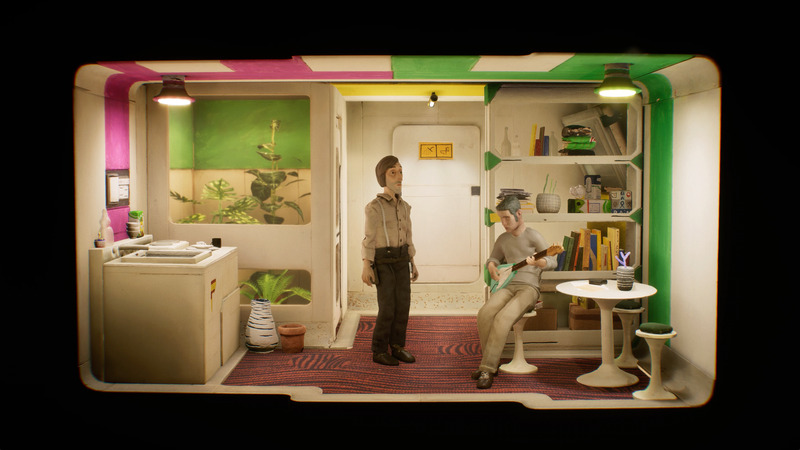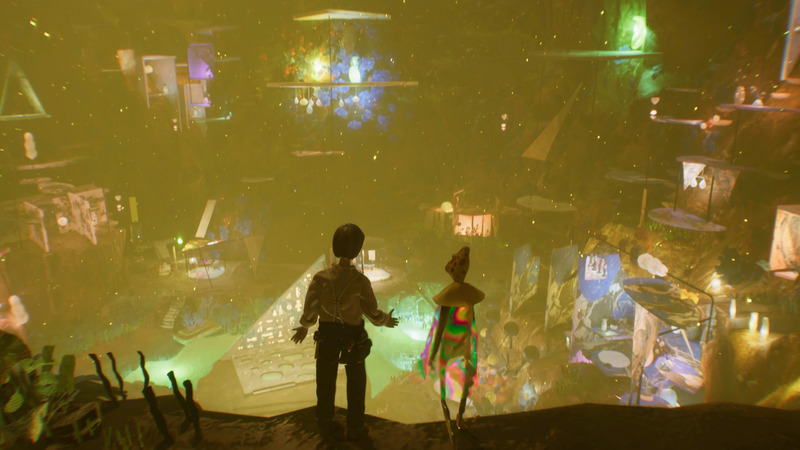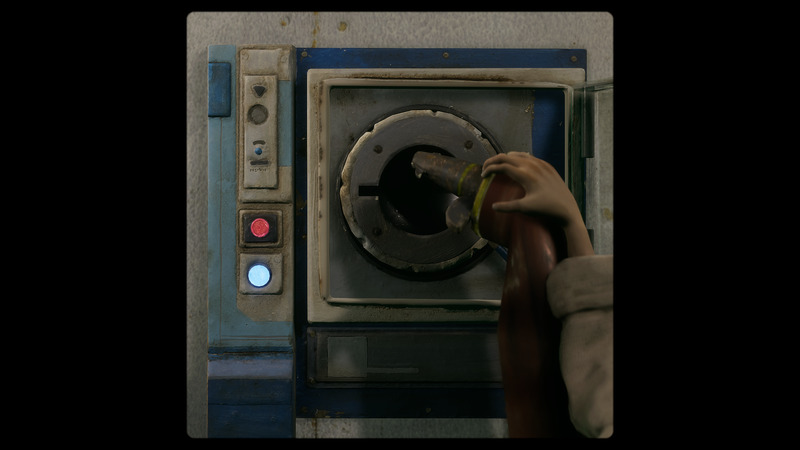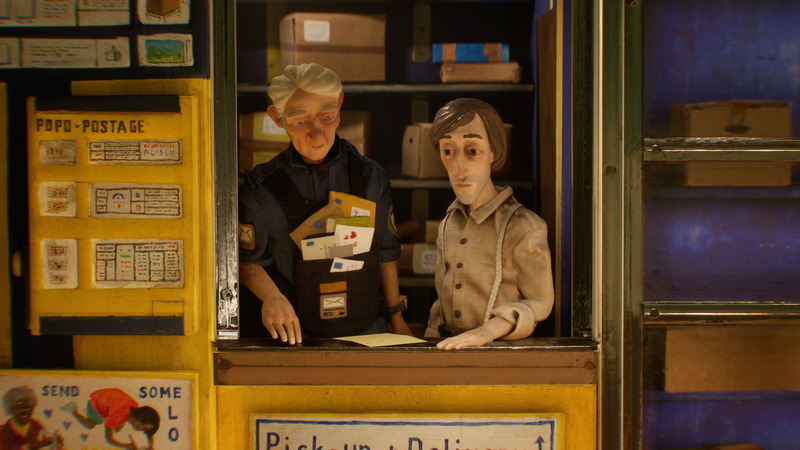Harold Halibut is the long awaited debut title from indie developer Slow Bros. The German studio, based out of Cologne, describes the game as a “hand made” adventure, a term that should definitely be taken more literally than you would probably expect. You see, when Slow Bros was founded by a group of long time friends back in 2015, they went on to assemble quite an eclectic group of people to help make Harold Halibut. Of course, there were people brought on with backgrounds in expected things like video game production and film making, but also people with backgrounds in more unexpected things like apparel design and even carpentry. You might be asking yourself why you would need those last two to make a video game, which is a totally fair question. However, once you see Harold Halibut in action, the question becomes: why can’t more teams do this?
Now, I’m going to break standard “game review protocol” for a moment and jump straight into talking about the game’s presentation. When I first laid eyes on the game’s reveal trailer, I definitely did a double take as I had never seen a game look like that. Being curious about how this look was achieved, I decided to do some digging into Slow Bros and was amazed with what I found. Nearly everything in this game, from the geometry, environments, and the objects within them, to the characters and even the clothes on their backs, is handmade. As in, it’s all built by hand, in real life by carpenters, apparel designers, and sculptures. Through the art of photogrammetry, those real life creations are then scanned into the game engine, giving the game its iconic look and feel. This is such a creative way to craft a game world and its characters, and I just wanted to commend the team for their efforts. If you want to take a deeper look at how this was accomplished, I highly recommend checking out their Kickstarter pitch video, which I will link below. With that being said, perhaps now I should talk about the game itself?
Too Much Water
As mentioned previously, Harold Halibut is an adventure game where you step into the shoes of the titular character, Harold. Harold is a lab assistant aboard an ark-like spacecraft known as The Fedora. Approximately 250 years ago, Earth was not looking long for this world as conflicts between nations began to escalate to near nuclear levels. Once a hospitable planet with water was discovered somewhere in deep space, The Fedora was sent to colonize it and restart humanity. Upon arrival and subsequent crash landing, the crew of the Fedora quickly realized they may have gotten more than they bargained for as the planet was made up almost entirely of water. While not exactly what they were expecting, the crew made the most of it and used the many compartments of the ship to form a Rapture-esque underwater civilization.

Jumping back to present day, the population has grown, and governments and corporations have been formed as The Fedora has become its own makeshift town. Functionally speaking, the Fedora operates just like a small village, with everyone having their own job, doing things such as running a restaurant, running a post office, leading scientific research, and everything in-between. Unfortunately for Harold, although his title is technically “Lab Assistant,” in actuality he is treated more like a janitor, constantly being asked to clean this and fix that. Combined with his aloof and introverted personality, he is often looked over by the community.

Life on the Fedora is equal parts mundane and orderly, as an organization called the All Water Corporation oversees everything that goes on. As it turns out, energy conservation is of utmost importance when living in a spaceship at the bottom of the ocean. It’s because of this that All Water exhibits a lot of control over the things, up to and including powering things down at night and managing people’s travel between districts. That travel is done by the toilet-esque underwater tube transit system built post crash to connect the ship’s different hubs. Everyone’s lives get turned upside down, though, when a message from Earth comes through after all this time affirming to everyone that the nukes didn’t go off and nothing super bad ended up happening. This news causes everyone to want to return home, and it’s up to scientist Jeanne Mareaux, her assistant Harold, and the rest of the citizens to figure out a way off this planet. However, blasting into space takes a lot of energy, and, with that energy being in such short supply, everyone has different ideas on what to do, including looking beyond The Fedora’s walls.

Living In a Sunken Hat
After playing through the game’s brief introduction sequence, a lot of The Fedora is opened up to be explored. The ship is broken up into several districts which act as hubs that you can freely walk around. These districts are more or less themed, with one district containing shops and restaurants and others containing administration offices, research labs, classrooms, and so on and so forth. While these areas are quite small, they are also very detailed. The fact that all of these places were constructed as real life sets helps make them all quite distinct from each other. There is just not a lot of recycling of assets going on here. This is a huge plus as a large part of the game play loop is being asked to travel to and from various locations, and I was able to memorize each one after just one visit. The camera work also subtly provides the feeling of you walking around a set as walking towards the southern edge of the screen reveals what feels like the edges of a stage. In addition to this, the game’s soundtrack fills out the rest of the world quite well, knowing exactly when to show up and when to seamlessly fill out the background. The world is presented very well and is easily one of the strongest aspects of the game.

The same can be said for the many denizens of The Fedora. There are several characters you will interact with throughout the game’s narrative, and many of them are also visually distinctive and run the gamut of personality types. I realize that at this point I’m kind of obsessing over this aspect, but with each character that gets introduced, knowing that everything from their face to the clothes on their back were handcrafted by sculptors and apparel designers, caused me to examine everything about them much more closely than I would in other games. As a film buff who is always interested in things like set and costume design, I sometimes felt more like I was watching Harold Halibut the motion picture instead of playing the game. I mean that as a complement, at least for now.

We Are Harold
The game has a clear influence from dry British humor and the quirkiness of famous stop motion productions like Wallace and Gromit. This influence shines through with all of its characters, but none more than Harold. He’s weird, he’s awkward, but he’s also lonely and unsure of himself and his place in this underwater society. As you wander around the ship interacting with other people and doing odd jobs, Harold comes off as a dopey but dependable goofball. During the quiet moments, though, you get to realize just how introspective and expressive he can be. It’s clear he’s fighting an all-too-common internal battle of wanting more out of life, yet being afraid to change the status quo. With an excellent performance from Andrew Nolen, his inner monologues between conversations really allow him to shine as a charming lead that you never get tired of controlling. A lead character facing real, everyday human emotions is easy to root for, after all.

As the story unfolds and the citizens aboard The Fedora scramble to find a way home, Harold’s status as the quiet guy in the background starts to shift as his set of skills becomes a hot commodity. This eventually escalates significantly when Harold finds himself at the forefront of the discovery of an alien life form, which, in turn, blossoms into his first real friendship. It’s a discovery that leads him to tackle his fear of breaking the cycle he’s in and becoming a fish out of water. A narrative turn where the fact that this is happening to a man named after a fish, who lives in the water, is not lost on me. Harold’s emotional journey and how he fits into this beautifully constructed world and its quirky inhabitants was the main thing pulling me towards the end of this game, with “game” being a term that I unfortunately have to use a bit loosely…

There and Back Again
Earlier I complemented Harold Halibut’s presentation as often feeling more like watching a movie versus playing a game. That sentiment is still true; however, that aspect is somewhat of a double-edged sword as this is still a video game we are talking about, after all. Adventure games, in general, are not normally known to have extreme variety in terms of their mechanics, but the best in the genre are still able to keep you engaged with strong narrative hooks, great pacing, and some clever puzzles. Unfortunately, Harold Halibut struggles with this at times.

The game does have memorable characters and does a good job at building its world; however, the main narrative takes a long time to get going. This is exasperated by the fact that there is very little on offer from a gameplay perspective. Key aspects of other adventure games, like choice and consequence, collectables, hidden secrets, or puzzles are nearly completely absent here. This causes the main gameplay loop to consist of constantly traveling from point A to initiate a conversation at point B and rinse repeat for 10-12 hours. This maybe could be passable if the game’s story line was well paced, but it really doesn’t begin to build until around the halfway point. To make matters worse, there are several B and C plots that had some interesting seeds but seemed to fizzle out or be abandoned completely by the game’s end.

Perhaps the game’s most egregious offense is the few instances in which I felt like my time was not respected. An example I’ll give is in the middle of the game; you find a stack of letters in your room and are tasked to deliver them to several people around The Fedora. Most of these people reside in different districts, so you must venture around The Fedora to find them. However, the game only lets you hold one letter at a time. This means you are picking up a letter, traveling to another part of the ship, going through a minimum of two to three fast travel sequences and then returning to where you started only to do it all over and over again. It’s long stretches like this, where the simple act of playing the game ends up feeling like a barrier between dialogue sequences. This is a real shame because its moments like this that pull you straight out of the immersive world the team at Slow Bros worked so hard to build.

Your time cosplaying as a mailman is not all doom and gloom, though, as the sequence ends with one of the game’s best narrative moments. So when I completed it, I was left agonizing over whether it was all worth it or if I truly did just waste my time. In the end, I begrudgingly lean towards the former, but with how great the game’s other aspects are, it’s a decision that should never have been that hard. It’s a perfect microcosm of what it’s like to play Harold Halibut
In the end, the spectacular presentation, fantastical world, and charming characters were enough to carry me through the game’s overly long and slow start, as well as look past the very limited aspects of its gameplay. It was a long time coming, but when the curtains finally closed on Harold’s journey, I was happy to have seen it through. I’m very interested in the future of Slow Bros, and if they can act on lessons learned here, what comes next could be truly special.
You can find Seasoned Gaming’s review policy here.



